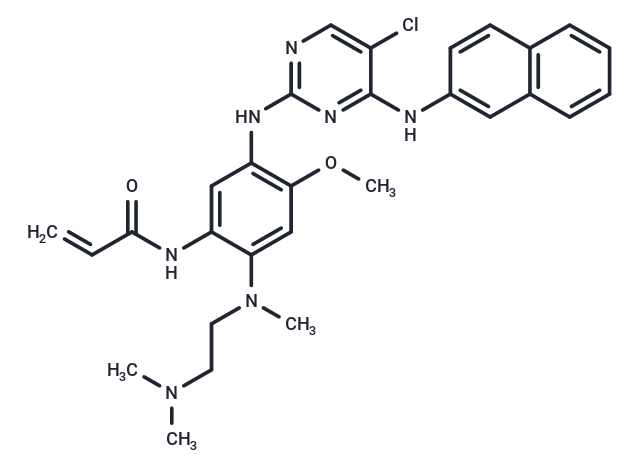Shopping Cart
- Remove All
 Your shopping cart is currently empty
Your shopping cart is currently empty

Limertinib (ASK120067) is an orally active and highly efficient epidermal growth factor receptor (EGFR) tyrosine kinase inhibitor targeting EGFR T790M. Limertinib can be used for studying non-small cell lung cancer.

| Pack Size | Price | Availability | Quantity |
|---|---|---|---|
| 1 mg | $83 | In Stock | |
| 5 mg | $197 | In Stock | |
| 10 mg | $333 | In Stock | |
| 25 mg | $670 | In Stock | |
| 50 mg | $871 | In Stock | |
| 100 mg | $1,230 | In Stock | |
| 200 mg | $1,670 | In Stock | |
| 1 mL x 10 mM (in DMSO) | $263 | In Stock |
| Description | Limertinib (ASK120067) is an orally active and highly efficient epidermal growth factor receptor (EGFR) tyrosine kinase inhibitor targeting EGFR T790M. Limertinib can be used for studying non-small cell lung cancer. |
| Targets&IC50 | PC9:6 nM, EGFR (WT):6 nM, H1975 (EGFR T790M):12 nM, HCC827 (sensitive mutation):2 nM, EGFR (T790M):0.5 nM (IC50), EGFR (L858R/T790M):0.3 nM (IC50), EGFR (exon 19 deletion):0.5 nM (IC50) |
| In vitro | In an in vitro kinase assay, Limertinib exhibited potent inhibition of EGFR L858R/T790M and EGFR T790M resistance mutants with IC50 values of 0.3 nM and 0.5 nM, respectively, as well as a sensitive mutant with deletion of EGFR exon 19 (IC50 = 0.5 nM). In comparison, Limertinib has an IC50 of 6 nM against wild-type EGFR (EGFRWT). [1] Limertinib selectively inhibited the proliferation of EGFR-mutant cell lines and exhibited significant antiproliferative activity in non-small cell lung cancer (NSCLC) cells harboring mutant EGFR, with IC50 values of 12 nM, 6 nM, and 2 nM for NCI-H1975 (T790M mutation), PC-9, and HCC827 cells (sensitive mutation), respectively.[1] In the concentration range of 0.1-100 nM, Limertinib inhibits phosphorylation of EGFR at tyrosine residue 1068 and inhibits phosphorylation of its downstream signaling proteins, AKT and ERK, in NCI-H1975 cells (EGFR L858R/T790M), even at low concentrations of 0.1-1 nM. In addition, it reduced the expression levels of p-EGFR, p-Akt, and p-ERK in EGFR WT A431 cells when Limertinib concentration reached 10-100 nM. [1] |
| In vivo | By oral administration (5-20 mg/kg once daily for 21 days), Limertinib significantly slowed down tumor growth with a tumor growth inhibition (TGI) of 85.7%. When administered at a dose of 10 mg/kg, Limertinib significantly reduced tumor growth with a TGI rate of 99.3%, showing similar efficacy to Osimertinib. [1] |
| Alias | ASK120067, ASK 120067 |
| Molecular Weight | 546.06 |
| Formula | C29H32ClN7O2 |
| Cas No. | 1934259-00-3 |
| Smiles | O=C(C=C)NC1=CC(NC2=NC=C(Cl)C(=N2)NC=3C=CC=4C=CC=CC4C3)=C(OC)C=C1N(C)CCN(C)C |
| Relative Density. | 1.307 g/cm3 (Predicted) |
| Storage | store at low temperature,keep away from moisture,keep away from direct sunlight | Powder: -20°C for 3 years | In solvent: -80°C for 1 year | Shipping with blue ice. | ||||||||||||||||||||||||||||||
| Solubility Information | DMSO: 40 mg/mL (73.25 mM), Sonication is recommended. | ||||||||||||||||||||||||||||||
Solution Preparation Table | |||||||||||||||||||||||||||||||
DMSO
| |||||||||||||||||||||||||||||||

Copyright © 2015-2025 TargetMol Chemicals Inc. All Rights Reserved.